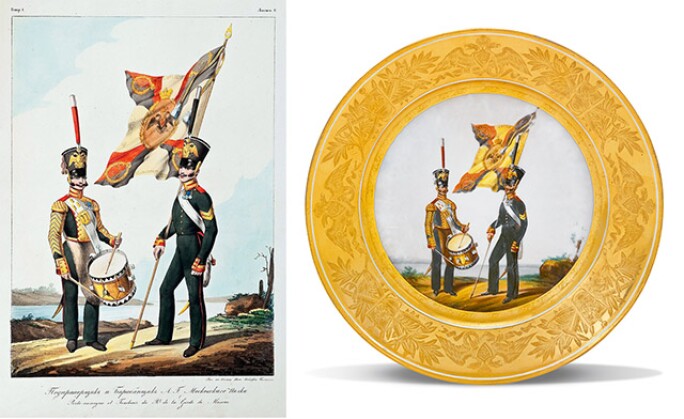T he Russian Works of Art, Fabergé & Icons sale in London on 28 November includes a fine collection of sixteen military plates from the period of Emperor Nicholas I (1796-1855).
The Emperor was a patron of the arts and had a particular interest in the production of his porcelain factory. It was during his reign, which began in 1825, that the Imperial Porcelain Factory in St Petersburg reached its peak, with technical and artistic advances encouraged by the emperor himself.

ENSIGN AND DRUMMER OF THE REGIMENT OF THE MOSCOW GUARDS: A PORCELAIN MILITARY PLATE, IMPERIAL PORCELAIN MANUFACTORY, ST PETERSBURG, PERIOD OF NICHOLAS I, DATED 1841. ESTIMATE: £15,000-20,000
Previously, Russian porcelain had consisted of only Russian clay, in keeping with the decree of Empress Elizabeth Petrovna, who established the factory in 1744 and patriotically insisted that its porcelain should be entirely ‘of Russian earth’. Nicholas I, although very much a Russian nationalist, reversed this edict and ordered the importation of kaolin from Limoges; this allowed for the firing of larger, sturdier wares. New lead-based fluxes and oxide tints meant an expanded palette of colours. There were also advances in firing techniques and the invention of a durable fire-gilding which could be burnished.

ARTILLERY COMPANY OF THE SAILORS OF THE GUARD AND TRANSPORT COMPANY OF THE SAILORS OF THE GUARD: A PORCELAIN MILITARY PLATE, IMPERIAL PORCELAIN MANUFACTORY, ST PETERSBURG, PERIOD OF NICHOLAS I, DATED 1836. ESTIMATE: £30,000 — 50,000
In 1827, shortly after the beginning of his reign, the emperor commissioned the first series of 120 military dessert plates, possibly inspired by an earlier series of similar wares produced at KPM in Berlin. Their subjects came from a variety of sources, including Sobranie mundirov rossiiskoi imperatorskoi armii (A Collection of Uniforms of the Imperial Russian Army), published in 1830 with lithographs by military draftsmen P. Alexandrov and L. Belousov. The Emperor was delighted with the results. The precise and faithful rendering, which appealed to the exacting emperor, is demonstrated by three plates, illustrated in this article alongside their original sources:

DRUM MAJOR AND FLAGBEARER OF THE SAILORS OF THE GUARDS: A PORCELAIN MILITARY PLATE, IMPERIAL PORCELAIN MANUFACTORY, ST PETERSBURG, PERIOD OF NICHOLAS I, DATED 1830. ESTIMATE: £32,000 — 45,000
Nicholas I later sent more than 200 plates to his father-in-law, King Friedrich Wilhelm of Prussia, who incorporated them in the decoration of his new pavilion at Charlottenburg Palace in Berlin. Military plates remained popular; production continued uninterrupted throughout the 19th century, the last additions made during the reign of Nicholas II, with designs being changed when uniforms were altered.
The Russian Works of Art, Fabergé & Icons sale includes thirteen examples from the earliest additions to the first service and date from 1828 to 1836; an additional three plates were produced in 1841. The finest painters-decorators are represented, with five by N. Yakovlev, three by S. Daladugin, two each by P. Savelyev and V. Yelashevsky, who served as head of the painting workshop, and one each by F. Daladugin and Vasily Stoletev; just two of the plates are unsigned.


